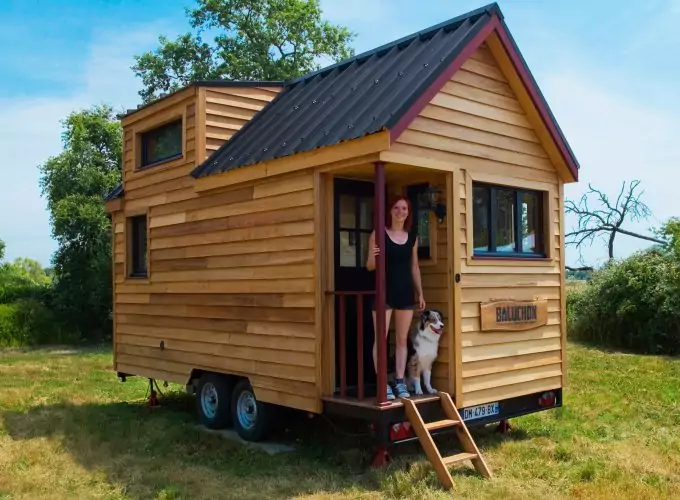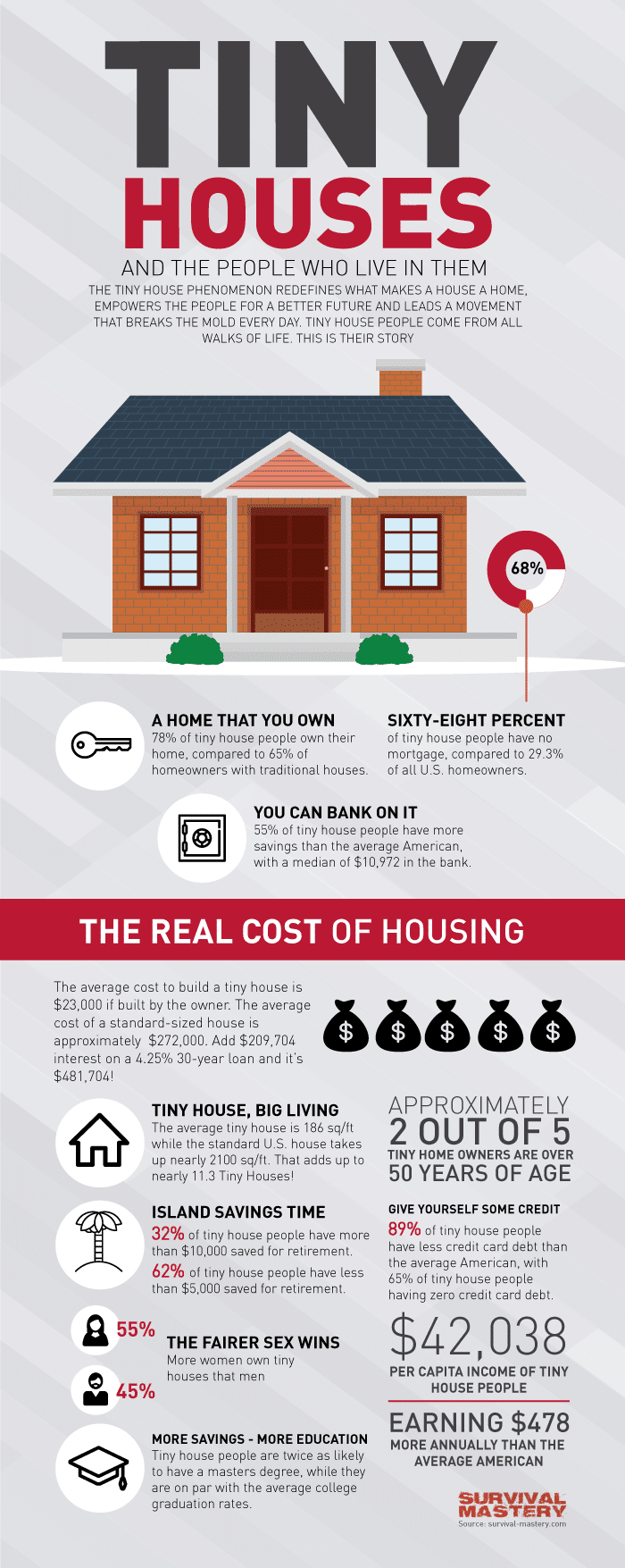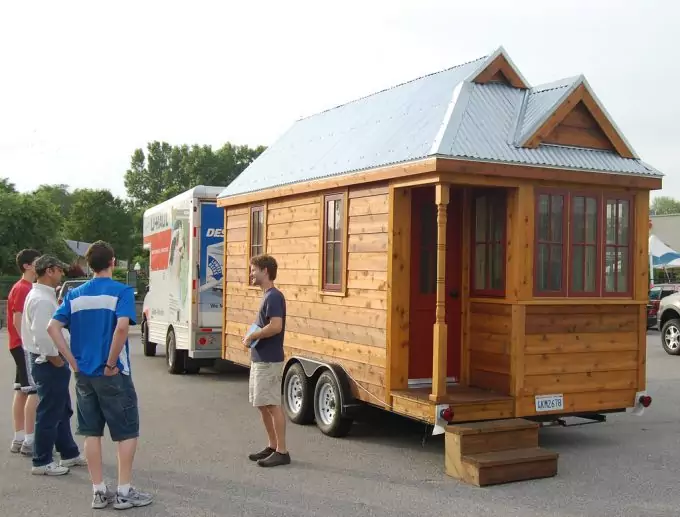The purchase of a house is a great social indicator that you have been at least moderately successful in your endeavors. Although there are ubiquitous floor plans, styles, and prices, nothing satisfies the human mind like owning a home. To some, a house means a family, and to others, it means quiet. The housing market’s success directly correlates to the economy’s success. If the economy struggles, then so does the housing market, which can turn into a slippery slope if not dealt with swiftly.
[the_ad_placement id=”in-text-1-type-r”]Recently, the United States experienced a housing market meltdown unlike many had previously seen. Not only was the economy in a recession, but also the housing market bottomed out and left Americans with nowhere to turn. Because people were overbuying houses, the market ended up collapsing on itself, and many families lost their homes. In an effort to combat the fragile housing market, certain investors began looking into tiny houses. These tiny houses were designed to be lived in comfortably for a fraction of the price of a regular home.
They do not occupy more than 500 square feet usually and can be moved almost anywhere with a truck. The tiny house movement was first thought up as a way to shelter hurricane Katrina victims, but later, was redesigned for public sale. Now that developers had a slice of the pie, they were free to promote these tiny houses as a way to stay afloat in the current housing market, but they also took advantage of other niches like resort style tiny houses to maximize profit.
The tiny housing movement has swept the United States by storm, and continues to expand, due to the high volume of people looking to save some money and live simpler, by way of tiny house.
The why of tiny houses
In order to hold a conversation about tiny house living, you must first understand why tiny houses have become necessary. In general, housing has been on the rise since the end of World War II. The United States was on an upward trend all the way up until the 2007-08 meltdown. The size of a home before the housing crisis was quite astonishing. If you fell into middle class, you most likely sported a large house, much larger than the housing market would normally allow someone to afford.
After the financial problems, many families were left without a place to live, and were running out of ideas. This is where tiny houses come into play. As I previously mentioned, tiny houses were first made public in the wake of hurricane Katrina. Instead of using the FEMA trailers to live in, some families chose to live in these tiny houses. They were, in fact, small, but what they lacked in size, they gained back in price.

Image credit: tumbleweedhouses.com
These tiny living houses were manageable by almost all families, and were a great solution to temporary housing. After Katrina victims had moved on, there was a large following for these tiny homes. Many important investors wanted the opportunity to make money on this new way of living, These investors knew that Americans would want an escape from the drowning housing market, and they couldn’t think of a more perfect way to satisfy the people than tiny house living.
There were two main reasons behind the push for tiny house living to become commonplace. First, the price caught the attention of potential buyer, and then the ecological benefits followed suit. Rather than making a large down payment and struggling to pay off an expensive mortgage for twenty years, younger adults are choosing to rent or buy cheap, fixable houses.
Tiny house living gives a perfect housing to these young adults. Purchasing a tiny house would allow them to save up additional money for a larger house and let the owners take the house to whatever part of the country they choose to settle down in. As for the ecological side, tiny houses are productive way to live.

They use less energy than normal houses would, while also being adaptable for greener energy. They are easier to sustain using only solar energy due to their small size and you can learn more about this from our article on amount of solar energy needed in a home.
These tiny houses are ecologically friendly, do no damage to the earth they sit on, but can be moved if anything were to happen. In summary, tiny house living satisfy an itch that the American people have to live cheaper, simpler, and greener, especially the younger adults, still new to the ways of the world.
Uses of tiny houses
Tiny house living can be a positive for people from all types of backgrounds and personalities. Whether a couple looking to live together, resort looking for onsite housing, or a family searching for a weekend getaway, tiny houses are for everybody. While widely popular for a low number of inhabitants, it would be a stellar trip for kids to take. It would also be a great base for hunting in the woods. There are limitless possibilities for how to uses these great housing options.
While private use is extremely popular, many organizations have began competitions, town fairs, conventions because of these small living arrangements. During some of these competitions, builders compete to see who can build to best tiny house with limited materials. Some even try to build the houses on a tiny budget, seemingly impossible to accomplish. Countries from all over the world have their own style of tiny houses, and competitions as well. The tiny house movement is truly an international thing.
More specifically, tiny houses are a great alternative to college housing (also known as dorm living), hotels rooms, and any other difficult, cramped place to lie down. In certain cities, the tiny houses were being used as a way to rehabilitate the homeless. The tiny houses acted as a halfway house of sorts, where the homeless could inch themselves back in to society, without having to fret over finding an empty shelter at night. On top of the homeless, any recently displaced family could find a tiny house to call home in the right city.
These tiny houses were a blessing to many people who lost everything they had in the financial crisis. The final type of tiny house is made with wheels. Tiny houses with wheels make moving the houses even easier, while maintaining the cheap price and personal feel tiny house living tries to create.

Image credit: tinyhousetalk.com
A common question surrounding the tiny house on wheels is how a tiny house is different from an RV. The answer is greatly. RVs are built to be moving constantly. The tiny houses with wheels are built to stay in one place, but also move if needed. These tiny houses are made like a real house is made.
The same traditional ways of building are put into the tiny house so that they last just as long as an actual big house with a foundation would last. In summary, lower class to high class, poverty to riches, all Americans have a reason to want a tiny house. The only question is where to put it. Of course, you can also consider building it from scratch and for this, you will need a few more information. We have a great article on how to build a tiny house that may be of great help in this case.
What’s happening today?
Since the tiny house living movement started almost ten years ago, it has kept growing and growing, even today. More people join every day, in hopes to build their own tiny home to live in. The movement has become so mainstream that there is even a TV show or two about tiny house living and building.
Due to the stark increase in tiny house popularity, many different types of builders have joined the ranks. For the first time, professional, experienced builders meshed with those with little to no experience building houses. Tiny houses don’t require any exceptional skills, but rather a dedication to learning the fledgling craft is all that is needed to successfully finish a tiny house.
[the_ad_placement id=”in-text-2-type-r”]However, this has caused many problems for the industry and led to the implementation of governing bodies with the mission of unifying all makers for safety reasons. These governing bodies decide what safe recipes are used in the construction of a tiny house, so to reduce the chance of an accident later. Towns have even fenced off spaces to promote the use of tiny houses. These tiny house communities can be regulated in price, as well as construction techniques, in order to ensure the happiness of the residents.

While some cities have been tiny house friendly, a larger number of cities have tried to ban the use of tiny houses. See, most cities have a specific way of zoning their land, whether it is for residential, commercial, or industrial. Well, the problem is that they have no classification for a tiny house. Their laws only allow construction to be started at a certain minimum level of square footage, mostly larger than what would constitute a tiny house.
Because of these laws, tiny houses are having a tough time finding ground to live on publicly. Another current disadvantage in the tiny house world is when it comes to campgrounds. As you know, campgrounds are there to hold tents, campers, and RVs for those who need respite while on the road or just taking a family trip. Some campgrounds have laws to disallow tiny houses from entering their establishment.
This is mostly due to the fact that tiny houses aren’t officially made by the manufacturers that RVs are made by. Even though there is a bunch of opposition to tiny house as a solution to housing needs, people have banded together to help support the cause as well.
Just this year, the American Tiny House Association was formed to promote tiny houses everywhere, and allow them to become a workable housing solution of the future. Alongside their mission to help all tiny house owners, is a promise to educate the public and government about the viability of tiny houses. Also they aim to start a positive discussion in the political world so that tiny houses can become a formal way to live in the United States.
After all, this is the land of the free. On top of all the great things the Association does in representing the people, they hope to guide builders on how to maintain the ecological friendliness tiny houses were built on and to help places struggling with pollution. As you can tell, more people are in support of tiny houses, but there is also more opposition to the idea of tiny houses.
Hopefully, through discussion and new laws, the government will see the positives of tiny house living and make a concerted effort to better housing communities all over the still recovering United States.
For and against a tiny house
You have seen the evolution of the tiny house from its beginnings as a way to help those in dire need after a natural disaster, all the way to the current situation of tiny houses in America. Now it is time to jump into the specifics of tiny houses, and analyze if a tiny house is truly worth the effort. Because it’s always better the get the bad news first, let’s see what could hinder the tiny houses ability to change the housing situation in this country.
There are only a few things that the tiny house has going against it, but owners should be aware of them nevertheless. As previously mentioned, tiny houses can run into problems with zoning and permits due to the tiny houses’ small size. In most places there is a minimum square footage that has to be blueprinted in order to build on a certain piece of land. This could cause problems for many people; because having a tiny house means that there is no limit on the lower end for square footage, only a maximum of around 50 square feet.

Image credit: tinyhouseswoon.com
More than likely, this can be solved by persistence in the political discussions about housing development. The only other downside to owning a tiny house is that the people around you could create a problem. Some homeowners could be upset that the house is so small; that they might think it will hurt the value of their homes. If the surrounding community members don’t like the tiny house, then they could push for the eviction of the community. While this doesn’t happen often anything is possible when money is involved.

Tiny house living has a vast number of advantages to living in them, and most of the houses will at least indirectly save the owner money. First, the obvious advantage is saving money on the sheer size of a house.
Tiny houses can range anywhere from 100-400 square feet, depending on the desires of the purchasers. This saves an immense amount of money, considering themselves size of the 1,000 and 3,000 square feet houses that many Americans love. Because fewer materials are used, the cost of materials and thus the cost of the house are directly decreased.
Since the size of the house is smaller, it will take less electricity and water to supply a tiny house. In fact, it would be a massive reduction in power use from the larger homes mostly present today. There are less parts of the house that need repairing due to the deliberate build of a tiny house.
[the_ad_placement id=”in-text-3-type-r”]Alongside the physical size of a tiny house, people who live in tiny house seem to live a simpler, cleaner way of life. They have a different mindset than the majority of people looking for a place to live. The tiny house makes useless clutter ineffective as a way to decorate. Instead the would-be decorated space is transformed into useful utility spaces for the house. Most people live in a similar way to the type of house they buy.
Tiny house buyers tend to have an increased sensitivity for the environment, as they are living a simpler life in a tiny house, they seem to want to reduce emission form their house. Other typical benefits come in the form of tax benefits for helping the environment. Also, the tiny house on wheels doesn’t need a permit to set up in most places, making it an easy alternative for living almost anywhere.

Image credit: tumbleweedhouses.com
Perhaps the genius in tiny house living lies in the ability of builders and designers to use every bit of space in the entire home. Each part of the home usually doubles as another useful tool. For example, in some tiny houses, the dining room table will easily convert to a living room, capable of seating a moderate amount of people for a gathering.
Another example would be using vertical space to increase the usefulness of your new tiny house as a way to maximize space. No matter who builds the home, every tiny house is extremely customizable, with the only limiter being the actual square footage.
Tiny houses are the most efficient way to live if you are on any sort of budget. They allow each part of the house to be specifically chosen by the owner, and then built to the perfect specifications. There are few disadvantages, but copious advantages in favor of tiny houses, and it seems as if the public is only increasing in knowledge and support of this still young way to live in a home.
The tiny house movement is in full swing in America, leaving many less progressive patriots wondering what these tiny homes really are. For some, the possibility of living in a simplified home would terrify, but to the new, young generation, it thrills them. Fueling this unheard of following is the ability of the average young person to become a homeowner, while still being able to freely move if needed. The last thing the younger generations want is to feel stuck or cooped up somewhere.
The solution to housing problems in the United States can be significantly curbed by the tiny house. Whether the government must fund it or not is yet to be determined, but one thing is for sure; tiny houses save money and save the planet. Those are two things almost nobody can argue with these days.

To summarize, tiny house living has swept across the nation, with everybody from New York to Los Angeles wanting one. No matter if it is a vacation home, hunting base, or main home, the tiny can mold to any type of family dynamic. It’s a shame that so many great ideas must come out of human suffering.
First, hurricane Katrina, then the housing crisis forced homeless and poor alike to jump on the tiny house train. Who would have thought that almost ten years later, the tiny house movement would grow to become the force it is today.
Builders, owners, sellers, and organizations alike are fighting for the right to have a tiny house in any location desired. When a group of people bands together to support an idea that is both cost effective and ecologically friendly, you know a marvelous idea has been found. It must be nurtured and presented to those who could bring it to the public’s attention even more often. Maybe then efforts can be made in implement this new building technique into society, so that no one will go without a viable place to live, anywhere.






I have read of self-sustaining tiny houses before, I even saw one near the entrance of a forest and it was lovely. It was built on a trailer bed and can be moved around using a pick-up truck.
That’s a good tiny house you saw. You can try making one of your own.
If you ask me, I wouldn’t want to live in a tiny house. I just can’t operate properly in such a small space.
I wonder how many people here would like to live in such a small house.
A tiny house may not be convenient for day-to-day living. However, it is the perfect house for a getaway from urban chaos over the holidays.
Would you think remaking a boat into a tiny house could work?
I would figure mobility and practicality of it would make it quite attractive for a lot of people who like to move around a lot.
Yes, it can work, but as you have suggested- you have to figure out practicality and mobility.